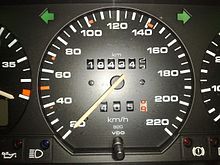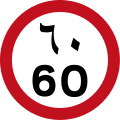Kilometres per hour
| kilometre per hour | |
|---|---|
 A car speedometer that indicates measured speed in kilometres per hour. | |
| General information | |
| Unit system | derived |
| Unit of | speed |
| Symbol | km/h or kph or km/hr or kmph |
| Conversions | |
| 1 km/h or kph or km/hr or kmph in ... | ... is equal to ... |
| mph | 0.621371 |
| m/s | 0.277778 |
| kn | 0.539957 |
| ft/s | 0.911344 |
The kilometre per hour (SI symbol: km/h; non-SI abbreviations: kph, km/hr) is a unit of speed, expressing the number of kilometres travelled in one hour.
History
[edit]Although the metre was formally defined in 1799, the term "kilometres per hour" did not come into immediate use – the myriametre (10,000 metres) and myriametre per hour were preferred to kilometres and kilometres per hour. In 1802 the term "myriamètres par heure" appeared in French literature.[1] The Dutch on the other hand adopted the kilometre in 1817 but gave it the local name of the mijl (Dutch mile).[2]
Notation history
[edit]
The SI representations, classified as symbols, are "km/h", "km h−1" and "km·h−1". Several other abbreviations of "kilometres per hour" have been used since the term was introduced and many are still in use today; for example, dictionaries list "kph",[3][4][5] "kmph" and "km/hr"[6] as English abbreviations. While these forms remain widely used, the International Bureau of Weights and Measures uses "km/h" in describing the definition and use of the International System of Units.[7] The entries for "kph" and "kmph" in the Oxford Advanced Learner's Dictionary state that "the correct scientific unit is km/h and this is the generally preferred form".[8]
Abbreviations
[edit]Abbreviations for "kilometres per hour" did not appear in the English language until the late nineteenth century.
The kilometre, a unit of length, first appeared in English in 1810,[9] and the compound unit of speed "kilometers per hour" was in use in the US by 1866.[10] "Kilometres per hour" did not begin to be abbreviated in print until many years later, with several different abbreviations existing near-contemporaneously.
With no central authority to dictate the rules for abbreviations, various publishing houses and standards bodies have their own rules that dictate whether to use upper-case letters, lower-case letters, periods and so on, reflecting both changes in fashion and the image of the publishing house concerned,[29] In contrast to the "symbols" designated for use with the SI system, news organisations such as Reuters[30] and The Economist[31] require "kph".
In informal Australian usage, km/h is more commonly pronounced "kays" or "kays an hour".[citation needed] In military usage, "klicks" is used, though written as km/h.[32]
Unit symbols
[edit]In 1879, four years after the signing of the Treaty of the Metre, the International Committee for Weights and Measures (CIPM) proposed a range of symbols for the various metric units then under the auspices of the General Conference on Weights and Measures (CGPM). Among these were the use of the symbol "km" for "kilometre".[33]
In 1948, as part of its preparatory work for the SI, the CGPM adopted symbols for many units of measure that did not have universally agreed symbols, one of which was the symbol "h" for "hours". At the same time the CGPM formalised the rules for combining units – quotients could be written in one of three formats resulting in "km/h", "km h−1" and "km·h−1" being valid representations of "kilometres per hour".[34] The SI standards, which were MKS-based rather than CGS-based, were published in 1960 and have since then have been adopted by many authorities around the globe including academic publishers and legal authorities.
The SI explicitly states that unit symbols are not abbreviations and are to be written using a very specific set of rules.[34] M. Danloux-Dumesnils[35] provides the following justification for this distinction:
It has already been stated that, according to Maxwell, when we write down the result of a measurement, the numerical value multiplies the unit. Hence the name of the unit can be replaced by a kind of algebraic symbol, which is shorter and easier to use in formulae. This symbol is not merely an abbreviation but a symbol which, like chemical symbols, must be used in a precise and prescribed manner.
SI, and hence the use of "km/h" (or "km h−1" or "km·h−1") has now been adopted around the world in many areas related to health and safety[36] and in metrology[37] in addition to the SI unit metres per second ("m/s", "m s−1" or "m·s−1"). SI is also the preferred system of measure in academia and in education.[38]
Non-SI abbreviations in official use
[edit]- km/j or km/jam (Indonesia and Malaysia)
- km/t or km/tim (Norway, Denmark and Sweden; also use km/h)
- kmph (Sri Lanka and India)
- กม./ชม. (Thailand; also uses km/hr)
- كم/س or كم/ساعة (Arabic-speaking countries, also use km/h)
- קמ"ש (Israel)
- км/ч (Russia and Belarus in a Russian-language context)
- км/г (Belarus in a Belarusian-language context)
- км/год (Ukraine)
- km/st (Azerbaijan)
- km/godz (Poland)
Regulatory use
[edit]
During the early years of the motor car, each country developed its own system of road signs. In 1968 the Vienna Convention on Road Signs and Signals was drawn up under the auspices of the United Nations Economic and Social Council to harmonise road signs across the world. Many countries have since signed the convention and adopted its proposals. Speed limits signs that are either directly authorised by the convention or have been influenced by the convention are shown below:
-
100 km/h sign following the most common implementation of the Vienna Convention style (Hungary)
-
Swedish 30 km/h speed limit – the yellow background provides a contrast in case snow covers the background against which one perceives the road sign.[39]
-
60 km/h speed limit in Arabic numerals (below) and Arabic script (above) (UAE)
-
Waterways speed limit of 9 km/h (Finland)
-
Samoa uses both miles per hour and kilometres per hour
-
50 km/h sign in Mexico
In 1972 the EU published a directive[41] (overhauled in 1979[42] to take British and Irish interests into account) that required member states to abandon CGS-based units in favour of SI. The use of SI implicitly required that member states use "km/h" as the shorthand for "kilometres per hour" on official[Note 1] documents.
Another EU directive, published in 1975, regulates the layout of speedometers within the European Union, and requires the text "km/h" in all languages,[43] even where that is not the natural abbreviation for the local version of "kilometres per hour". Examples include:
- Dutch: "kilometer per uur" ("hour" is "uur" – does not start with "h"),
- Portuguese: "quilómetro por hora" ("kilometre" is "quilómetro" – does not start with "k")
- Irish: "ciliméadar san uair"
- Greek: "χιλιόμετρα ανά ώρα" (a different script).
In 1988 the United States National Highway Traffic Safety Administration promulgated a rule stating that "MPH and/or km/h" were to be used in speedometer displays. On May 15, 2000, this was clarified to read "MPH, or MPH and km/h".[44] However, the Federal Motor Vehicle Safety Standard number 101 ("Controls and Displays") allows "any combination of upper- and lowercase letters" to represent the units.[45]
Conversions
[edit]- 3.6 km/h ≡ 1 m/s, the SI unit of speed, metre per second
- 1 km/h ≈ 0.27778 m/s
- 1 km/h ≈ 0.62137 mph ≈ 0.91134 ft/s
- 1 kn ≡ 1.852 km/h (exactly)
- 1 mph ≡ 1.609344 km/h
| m/s | km/h | mph (mi/h) | knot | fps (ft/s) | |
|---|---|---|---|---|---|
| 1 m/s = | 1 | 3.600000 | 2.236936* | 1.943844* | 3.280840* |
| 1 km/h = | 0.277778* | 1 | 0.621371* | 0.539957* | 0.911344* |
| 1 mph (mi/h) = | 0.44704 | 1.609344 | 1 | 0.868976* | 1.466667* |
| 1 knot = | 0.514444* | 1.852 | 1.150779* | 1 | 1.687810* |
| 1 fps (ft/s) = | 0.3048 | 1.09728 | 0.681818* | 0.592484* | 1 |
(* = approximate values)
See also
[edit]Notes
[edit]- ^ Until 2010, the directive covered "economic, public health, public safety or administrative purposes"; since then it covers all aspects of the EU internal market.
References
[edit]- ^ Develey, Emmanuel (1802). Physique d'Emile: ou, Principes de la science de la nature. Vol. 1. Paris.
- ^ de Gelder, Jacob (1824). Allereerste Gronden der Cijferkunst [Introduction to Numeracy] (in Dutch). 's-Gravenhage and Amsterdam: de Gebroeders van Cleef. pp. 155–156. Retrieved 2 March 2011.
- ^ "k.p.h.". Oxford English Dictionary (Online ed.). Oxford University Press. Retrieved 18 May 2022. (Subscription or participating institution membership required.)
- ^ "kph." Merriam-Webster.com. Retrieved 10 September 2023.
- ^ "kph." Collins English Dictionary. Retrieved 10 September 2023.
- ^ Journal of Research of the National Bureau of Standards: Radio propagation. D, Volume 65, pp. 122–126. 1961. National Bureau of Standards. Google Books. Retrieved 10 September 2023.
- ^ The International System of Units (PDF) (9th ed.), International Bureau of Weights and Measures, Dec 2022, p. 127, ISBN 978-92-822-2272-0
- ^ "kph abbreviation". Oxford Advanced Learner's Dictionary.
- ^ "The Oxford English Dictionary". Retrieved 13 July 2012.
- ^ Frazer, John F. (November 1866). Journal of the Franklin Institute of the State of Pennsylvania for the Promotion of the Mechanic Arts. Vol. LII. Philadelphia: Franklin Institute. p. 314.
- ^ Harrington, Mark W.; Rotch, A. Lawrence; Herdman, W. J. (May 1889). American meteorological journal: A monthly review of meteorology, medical climatology and geography. Vol. 6. Meteorological Journal Company. p. 226.
- ^ "Power consumed on electric railways". The Street Railway Journal. 11 (2): 116–117. February 1895.
- ^ Bulletin – United States Geological Survey, Volumes 151–152. USGS. 1898. pp. ix.
- ^ Whipple, F. J. W. (1899). "The Stability of the Motion of a Bicycle". The Quarterly Journal of Pure and Applied Mathematics. 30: 342.
- ^ Launhardt, Wilhelm (1900). The Theory of the Trace: Being a Discussion of the Principles of Location. Madras: Lawrence Asylum Press.
- ^ Swinburne, J (July 1902). Saunders, Lawrence; Blundstone, S. R. (eds.). "The Electric Problem of Railways". The Railway Engineer. 23: 207.
- ^ Figee, S. (1903). Observations Made at the Royal Magnetical and Meteorological Observatory at Batavia. Vol. 24. Government of Netherlands East India. p. 196.
- ^ Hobart, H. M. (1910). Electric Trains. New York: D. Van Nostrand Company. p. xix.
- ^ Ball, Jack (August 1911). "Foreign Notes on Aviation". Town & Country: 26.
- ^ Dodd, S. T. (January 1914). "A Review of Some European Electric Locomotive Designs". General Electric Review. 17 (1): 1141.
- ^ a b "Data on Mixed Motor Fuels of Interest for American Export Trade". The Automobile. 33 (15): 709. October 1915.
- ^ "Tractive resistance tests with an electric motor truck". Engineering and Contracting. 46 (25): 560. December 1916.
- ^ al-Jawwīyah, Maṣlaḥat al-Arṣād (1921). Meteorological Report for the Year [1916?]. Ministry of Public Works, Egypt. p. xvii.
- ^ Candee, A. H.; Lynde, L. E. (1922). "French Railway Begins Electrification Program". Railway Electrical Engineer. 13. Simmons Boardman: 392.
- ^ Blakemore, Thos. L. (1927). Pressure Airships. Ronald Press. p. 230.
- ^ Aircraft Year Book. Vol. 15. Aerospace Industries Association of America, Manufacturers Aircraft Association, Aeronautical Chamber of Commerce of America. 1933. pp. 391–393.
- ^ Bulletin. Central Electric Railfans' Association. 1939. p. cxii.
- ^ Thompson, Francis R. (1940). Electric Transportation. p. 165.
- ^ Truss, Lynne (2003). Eats Shoots and Leaves. Profile Books. pp. 188–189. ISBN 1-86197-6127.
- ^ Reuters Handbook of Journalism (PDF). Reuters. April 2008. p. 278. Archived from the original (PDF) on 2016-05-18. Retrieved 2012-08-06.
- ^ "The Economist Style Guide, 12th Edition" (PDF).
- ^ "klick". Oxford English Dictionary. June 2012. Retrieved 9 July 2012.
- ^ Quinn, Terry (2012). From Artefacts to Atoms: The BIPM and the Search for Ultimate Measurement Standards. Oxford: Oxford University Press. p. 132. ISBN 978-0-19-530786-3.
- ^ a b International Bureau of Weights and Measures (2006), The International System of Units (SI) (PDF) (8th ed.), p. 124, ISBN 92-822-2213-6, archived (PDF) from the original on 2021-06-04, retrieved 2021-12-16
- ^ Danloux-Dumesnils (1969). The Metric System: A Critical Study of its Principles and Practice. The Athlone Press of the University of London. p. 32.
- ^ "RLO: SI Units". School of Nursing and Academic Division of Midwifery; University of Nottingham. 1 December 2006. Archived from the original on 23 December 2012. Retrieved 21 July 2012.
- ^ "Information and Harmonization". International Bureau of Weights and Measures and International Organization of Legal Metrology. Retrieved 20 July 2012.
- ^ "OLA Editorial Style Guide" (PDF). Burnaby, British Columbia: Open Learning Agency (OLA), Government of British Columbia. 2000. Retrieved 26 July 2012.
{{cite journal}}: Cite journal requires|journal=(help) - ^ "Conspicuity and Signs: Road signing". International Federation of Red Cross and Red Crescent Societies. 2012. Archived from the original on 2012-11-02. Retrieved 19 September 2012.
- ^ "Department of Transport / An Roinn Iompair" (PDF). November 2010: 1. Archived from the original (PDF) on 28 April 2012. Retrieved 16 July 2012.
{{cite journal}}: Cite journal requires|journal=(help) - ^ Directive 71/354/EEC of 18 October 1971 of the European Parliament and of the Council on the approximation of laws of Member States relating to units of measurement
- ^ Council Directive 80/181/EEC of 20 December 1979 on the approximation of the laws of the Member States relating to Unit of measurement and on the repeal of Directive 71/354/EEC
- ^ Directive 75/443/EEC of 26 June 1975 of the European Parliament and of the Council on the approximation of the laws of the Member States relating to the reverse and speedometer equipment of motor vehicles
- ^ National Highway Traffic Safety Administration (May 2000). "Federal Motor Vehicle Safety Standards; FMVSS 101--Technical Correction--Speedometer Display". Federal Register. 64 (94): 30915–30918.
- ^ National Highway Traffic Safety Administration. Federal Motor Vehicle Safety Standard (101: Controls and Displays). p. 237.


![Swedish 30 km/h speed limit – the yellow background provides a contrast in case snow covers the background against which one perceives the road sign.[39]](http://upload.wikimedia.org/wikipedia/commons/thumb/2/2c/Sweden_road_sign_C31-3.svg/120px-Sweden_road_sign_C31-3.svg.png)
![Since the text "km/h" on this Irish speed limit sign is a symbol, not an abbreviation, it represents both "kilometres per hour" (English) and "ciliméadar san uair" (Irish)[40]](http://upload.wikimedia.org/wikipedia/commons/thumb/a/a4/IE_road_sign_RUS-043.svg/120px-IE_road_sign_RUS-043.svg.png)



